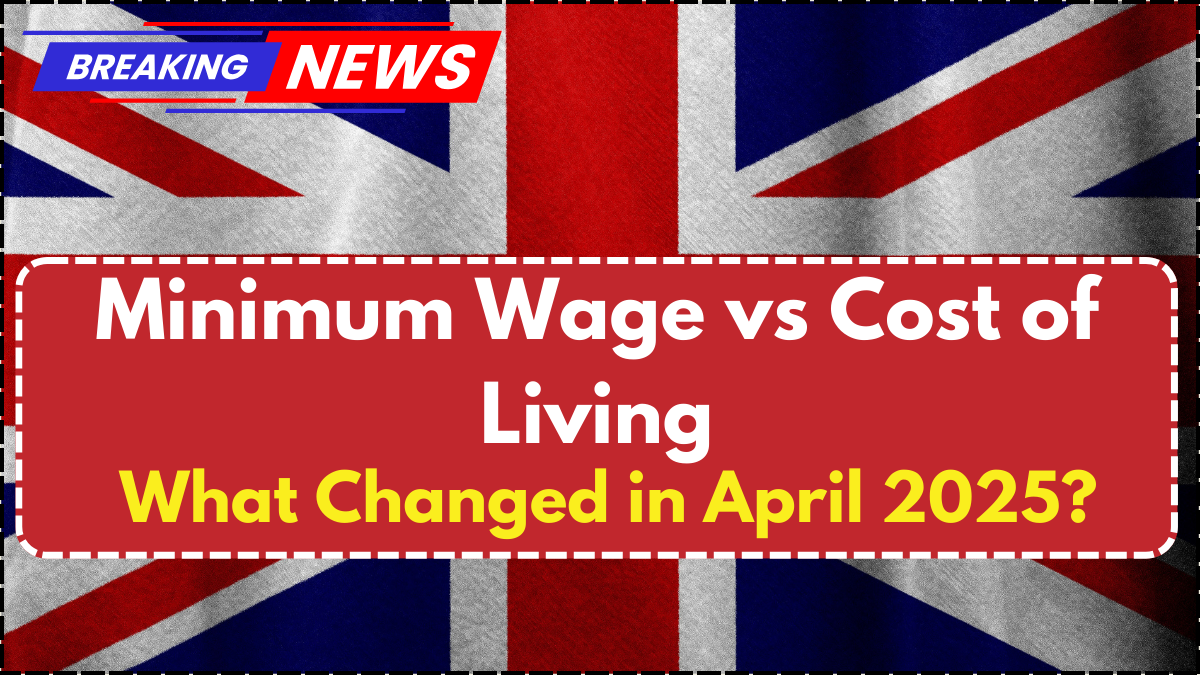From April 2025, the UK government will enforce updated National Minimum Wage (NMW) and National Living Wage (NLW) rates. Over three million workers are expected to benefit from these increases, which aim to improve income stability and help combat persistent cost-of-living challenges. The new wage structure supports the government’s wider economic strategy, promoting equitable pay across all demographics and industry sectors.

Comprehensive Breakdown of 2025 Minimum and Living Wage Rates
The following table outlines the upcoming wage changes, comparing them with 2024 rates to show the monetary and percentage increases:
| Category | Rate (April 2024) | Rate (April 2025) | Increase (£) | Percentage Change (%) |
|---|---|---|---|---|
| National Living Wage (21+) | £11.44 | £12.21 | £0.77 | 6.7% |
| 18–20 Year Old Rate | £8.60 | £10.00 | £1.40 | 16.3% |
| 16–17 Year Old Rate | £6.40 | £7.55 | £1.15 | 18.0% |
| Apprentice Rate | £6.40 | £7.55 | £1.15 | 18.0% |
| Accommodation Offset (Daily) | £10.66 | £11.33 | £0.67 | 6.3% |
What Is the National Living Wage in 2025?
Starting April 2025, workers aged 21 and over will receive a National Living Wage of £12.21 per hour, up from £11.44. This represents a 6.7% increase. For a full-time employee working 37.5 hours per week, this change translates to an annual salary increase from approximately £22,918 to £24,441.
This update supports the government’s goal to ensure all workers earn at least two-thirds of the national median wage. It also directly addresses the economic squeeze faced by many households, helping bridge income disparities.
Key Minimum Wage Increases by Age Group
The 2025 wage update significantly impacts younger workers and apprentices, increasing their financial independence and incentivizing workforce participation:
- Ages 18–20: The hourly rate increases from £8.60 to £10.00, a 16.3% jump.
- Ages 16–17: Pay rises from £6.40 to £7.55, an 18% increase.
- Apprentices: Also now earn £7.55 per hour, aligning with the 16–17 age group.
These changes reflect a commitment to fair pay for all age groups, ensuring that younger employees and trainees are not left behind.
How the New Wage Rates Will Benefit Workers
Workers across all sectors stand to gain from the wage increases in several ways:
- Higher Annual Income: A 21-year-old full-time worker will earn over £1,500 more annually.
- Stronger Financial Position: Extra earnings help cover rising costs such as rent, transportation, and groceries.
- Improved Living Standards: Increased wages enhance overall financial well-being, allowing for better planning and saving.
What Employers Must Do Before April 2025
Employers, especially in sectors with high volumes of low-wage employees, must prepare thoroughly to meet the new requirements.
Business Impact and Key Considerations:
- Labour Cost Increases: Businesses must budget for the higher wage bill.
- System and Process Updates: Payroll software and employment contracts need to be revised.
- Training and Communication: HR and payroll teams should be trained and ready to communicate these updates effectively.
Risks of Non-Compliance:
- Fines: Employers who fail to comply face penalties up to £20,000 per underpaid employee.
- Reputation Damage: Public exposure of wage violations can harm brand trust and employee morale.
Employer Action Checklist for Wage Compliance
To ensure a smooth transition:
- Update Payroll: Integrate the new rates into payroll systems before April.
- Notify Employees: Clearly inform all staff about changes to their pay.
- Revise Employment Contracts: Ensure documentation reflects updated rates.
- Conduct Training: Educate relevant teams on compliance and communication.
Who Is Eligible for the 2025 Minimum and Living Wage?
To qualify for the National Minimum or Living Wage, individuals must:
- Be aged 16 or over.
- Be legally employed in the UK.
- Work as an employee or classified worker (part-time, full-time, or casual).
- Be in a paid position (not self-employed or unpaid internships).
Conclusion
The 2025 wage reforms signal a strong push towards fairer compensation across the UK workforce. They not only aim to uplift millions of workers but also set a higher standard for financial security and equity in the labour market. For businesses, these changes bring new responsibilities but also an opportunity to reinforce trust and engagement with their workforce.
FAQs
What is the new National Living Wage in 2025?
From April 2025, the National Living Wage for workers aged 21 and above will be £12.21 per hour.
How much more will 18-20 year-olds earn in 2025?
They will earn £1.40 more per hour, increasing their pay to £10.00, a 16.3% rise.
Are apprentices receiving the same rate as 16-17-year-olds?
Yes, both groups will earn £7.55 per hour starting April 2025.
What are the penalties for not complying with the new wage rules?
Employers can be fined up to £20,000 per underpaid worker and face public naming by authorities.
When do the new wage rates take effect?
The updated rates come into force on 1 April 2025.
For More Information Click Here
Pari is a passionate writer known for captivating stories that blend imagination and reality. Inspired by travel, history, and everyday moments, Pari crafts narratives that resonate deeply with readers.
